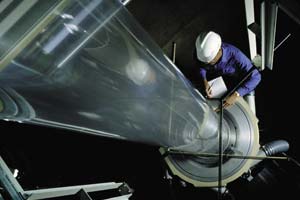Blown Film Extrusion
The process involves extruding a tube of molten polymer (typically polyethylene) through a die and inflating it to several times its initial diameter to form a thin film tubular bubble. This bubble is cooled as it is drawn upwards and eventually freezes, before collapsing to be wound and either slit for processing as a flat film or kept in tubular form for making plastic bags. Solidification occurs at the frost line and the position of this frost line is controlled by several parameters, such as airflow, speed and difference to the surrounding temperature.
- At a Glance
- Featured Solutions
- Resources
Temperature is an important process parameter. Maintaining integrity of both the molten and solid film is vital to avoiding bubble instability. Monitoring of the frost line can maximize this stability. Noncontact temperature measurement is the only way to measure the temperature of the moving film without damaging it.
- Monitoring the height and width of the frost line to ensure correct crystallization properties
- Measure the polymer temperature at the die to ensure the correct melt strength
- Measure the final temperature before rolling
- Measure the surrounding temperature
Get more information about Fluke Process Instruments solutions for this application


